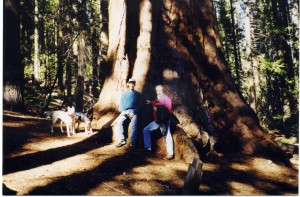
A heather-scented wind, salty-sea air, the ding-ding of cable cars, the hushed morning atop a mountain with snow unsullied by footprints, the sighing of wind through the redwood trees, the odd slant of the sun.
These are a few deeply etched memories of good times spent traveling. Many places still remain on my wish list. But I must say, I thoroughly enjoy armchair travel too. When an author crafts a setting that comes alive, that book skyrockets in my estimation. 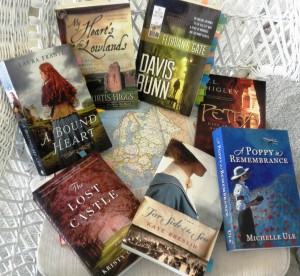 Pictured are a few that come alive in locations beyond the standard foreign fare of England or Paris.
Pictured are a few that come alive in locations beyond the standard foreign fare of England or Paris.
I’ve visited a slice of Scotland. But Liz Curtis Higgs, in her masterpiece of Scotland-love, My Heart’s in the Lowlands, takes us on a detailed tour along roads bordered by dry-stone dykes or hedgerows. We stop at her favorite inns and tearooms, moss-covered castle and abbey ruins, shops, and, of course, bookstores. It’s an insider’s tour of delights gathered over years of research visits to the Scottish Lowlands.
Laura Frantz continues the Scotland-love, introducing us to a rugged Scottish island in the fabulous A Bound Heart. I still want to visit those islands, but at least I’ve had a wee visit to one wild spot.
Tracy Higley’s Petra: City in Stone took me to an arid location I’d likely not choose and had assumed would be boringly repetitious. But she brought it alive. She and Nancy Rue in Healing Sands [not pictured] made the sandy/rocky setting anything but monotonous, and made me rethink my belief that deserts were boring. Michelle Ule joins them for making WW I Egypt come alive in A Poppy in Remembrance.
As I mentioned in my review of Kate Breslin’s Far Side of the Sea, many stories are set during the World Wars in the customary settings of England, France, Germany and such. But Breslin brings us to colorful, bustling war-time Barcelona. Davis Bunn in Florian’s Gate immerses us not only in post-war London, but poverty-stricken Poland with miles of decaying, gray farmhouses smothered with colorful flowers. His is a gripping mystery and romance in a come-to-life setting—well worth reading along with the others in The Priceless Collection set. Kristy Cambron in The Lost Castle spins a WW II tale of mystery and romance set in The Loire Valley of France. Perhaps this isn’t as unusual a location as the others I’ve included here, but it is outside the usual Paris-London-German-Italy quartet. Cambron brings her setting alive, and I’m eager to read her latest, Castle on the Rise, which is set in Ireland.
How alive some settings become surprised me. As I read one of Liz Curtis Higgs Scottish historicals, I could feel the different sensations on my tongue of the wooden spoons the poor used versus the silver utensils of the well-off, and it astonished me. If I cannot journey to a location, I look forward to traveling there via an excellent writer’s story.
So, as my friend Wendy Macdonald says, “I’m nosy to know:” What about you?
What places call to you?
Are you interested in locations outside the foreign settings that usually appear in U.S. published books? Perhaps Iceland? Albania? The Philippines? South Africa?
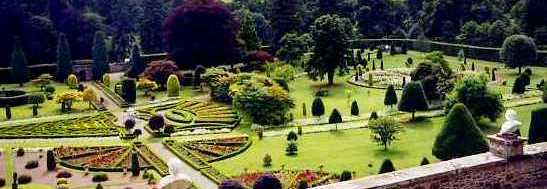
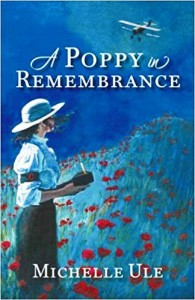 As World War I breaks out, Claire Meacham struggles to carve out a place in the male-dominated world of journalism. She struggles to hang on to hope while war tears her world apart. When she meets Oswald and Biddy Chambers, she adds another challenge—how to live out the teaching of Scripture. As the war grinds on, her new-found faith is tested and stretched.
As World War I breaks out, Claire Meacham struggles to carve out a place in the male-dominated world of journalism. She struggles to hang on to hope while war tears her world apart. When she meets Oswald and Biddy Chambers, she adds another challenge—how to live out the teaching of Scripture. As the war grinds on, her new-found faith is tested and stretched.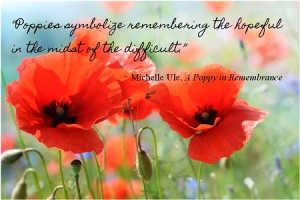 Ule has done an amazing job of braiding together stories that could each be a book unto itself: history, biography, romance, and an interesting coming-of-age tale. She weaves the various elements with sparks of beauty, wit, and wisdom.
Ule has done an amazing job of braiding together stories that could each be a book unto itself: history, biography, romance, and an interesting coming-of-age tale. She weaves the various elements with sparks of beauty, wit, and wisdom.